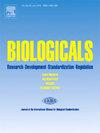基于噬菌体的兽医产品:调整监管框架和市场一体化的发展挑战
IF 1.5
4区 生物学
Q4 BIOCHEMICAL RESEARCH METHODS
引用次数: 0
摘要
抗菌素耐药性的出现重新引起了人们对噬菌体作为兽药中抗生素使用的补充干预措施的兴趣。IABS题为“避免抗菌素耐药性:噬菌体在预防、治疗和控制细菌感染中的兽医应用”的研讨会汇集了专家,讨论将基于噬菌体的产品推向市场所涉及的科学、监管和商业挑战。噬菌体的生物学特性需要创新的方法来进行产品开发和监管批准。根据其实际用途,噬菌体可以作为兽药产品、兽药制剂、食品添加剂或杀菌剂销售,每种分类都意味着不同的监管要求和挑战,而且最初都不是针对基于噬菌体的产品。会议强调需要进行监管协调,以促进市场准入,并允许制造商为其产品选择最适当的监管途径。最近的EMA和EDQM指南在考虑到噬菌体的生物学性质方面提供了一些灵活性,但人们仍然担心按照现有的兽医化疗药物规则以商业上可行的成本生产基于噬菌体的产品的可行性。克服这些监管和财政障碍对于整合噬菌体疗法作为兽医学控制细菌感染和疾病的治疗选择至关重要。本文章由计算机程序翻译,如有差异,请以英文原文为准。
Bacteriophage-based veterinary products: aligning regulatory framework and development challenges for market integration
The emergence of antimicrobial resistance renewed the interest in bacteriophages as complementary interventions to the use of antibiotics in veterinary medicine. The IABS workshop entitled “Avoiding Antimicrobial Resistance: Veterinary Use of Phages for Prevention, Therapy and Control of Bacterial Infections” brought together experts to discuss the scientific, regulatory and commercial challenges involved in bringing phage-based products to market. The biological characteristics of phages require innovative approaches for product development and regulatory approval. Dependent on their actual use, phages could be marketed as veterinary medicinal products, magistral preparations, food additives, or biocides, each classification implying different regulatory requirements and challenges, and none of which were originally intended for phage-based products. The meeting highlighted the need for regulatory harmonization to facilitate market access and allow manufacturers to choose the most appropriate regulatory pathway for their products. Recent EMA and EDQM guidelines offer some flexibility to take into account the biological nature of phages, but concerns remain about the feasibility of manufacturing phage-based products following existing rules for veterinary chemotherapeutants at commercially viable costs. Overcoming these regulatory and financial barriers is essential for the integration of phage therapy as a therapeutic option for control of bacterial infection and disease in veterinary medicine.
求助全文
通过发布文献求助,成功后即可免费获取论文全文。
去求助
来源期刊

Biologicals
生物-生化研究方法
CiteScore
3.70
自引率
0.00%
发文量
39
审稿时长
48 days
期刊介绍:
Biologicals provides a modern and multidisciplinary international forum for news, debate, and original research on all aspects of biologicals used in human and veterinary medicine. The journal publishes original papers, reviews, and letters relevant to the development, production, quality control, and standardization of biological derived from both novel and established biotechnologies. Special issues are produced to reflect topics of particular international interest and concern.Three types of papers are welcome: original research reports, short papers, and review articles. The journal will also publish comments and letters to the editor, book reviews, meeting reports and information on regulatory issues.
 求助内容:
求助内容: 应助结果提醒方式:
应助结果提醒方式:


